June 10 - 16, 2018: Issue 363
Australian Sailing's Barranjoey Pin Program Brings A “Change In The Wind”
The beautiful varnished hull of BARRANJOEY, currently on display at Wharf 7 and part of the Sydney Heritage Fleet Collection. Reproduced courtesy of the Australian National Maritime Museum
Barranjoey Pin Program Brings A “Change In The Wind”
Australian sailing great Iain Murray believes the establishment of the Barranjoey Pin alumni program brings sailing into line with other iconically Australian sports and lays a foundation from which subsequent generations can launch.
Murray - a 2008 Olympian, America’s Cup stalwart and current Australian Sailing Performance Director - was speaking at the public launch of the Barranjoey Pin at the Australian National Maritime Museum in Sydney on Tuesday.
The uniquely numbered Pins will be presented around the country this year and next to those athletes who have represented and continue to represent Australia at the highest levels in sailing. It is named after the yacht ‘Barranjoey’, which was sailed to Australia’s first Olympic sailing gold medal, at the 1964 Tokyo Olympic Games.
Murray - recipient of Pin No.159 - called on Australia’s top Olympic class sailors to utilise the knowledge offered by their predecessors, as they set about forging their own path.
“We’ve seen it very strongly in other sports, whether it be rugby or cricket, but it’s probably been missing in sailing a little bit,” Murray said.
“There’s a change in the wind and I think it’s time for us to hoist a different sail. Celebrating this with the awarding of these Pins is a good way to start.
“By producing this pin and bringing all these people back to the fold, having their stories exposed, having the people that are around available to come and talk to the young guys and share their experiences, I think it’s part of the brotherhood of where we’re trying to get to.
“We’ve all had our fun, had our successes, had our journeys representing Australia in sailing. There comes a time, I think, where you have a duty to put back in to your sport and try to make it better for the next group of sailors.”
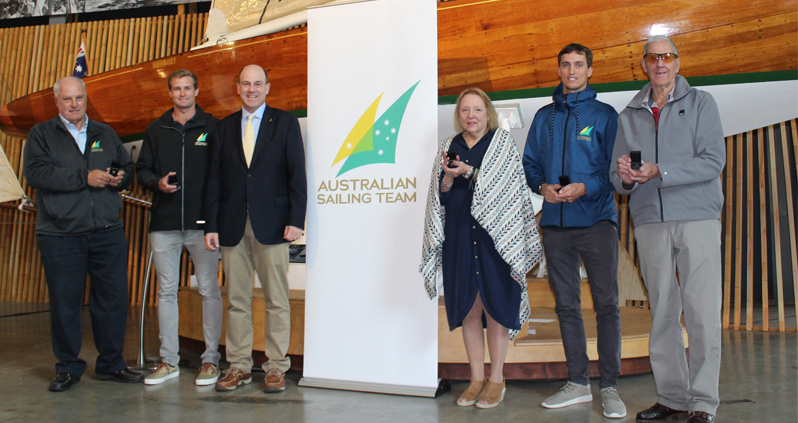
PHOTO: L-R Iain Murray, Joel Turner, Matt Allen, Virginia Jamieson, David Gilmour, ‘Dick’ Sargeant
Australian Sailing President, Matt Allen, said the Barranjoey Pin was a natural extension from the establishment of the Australian Sailing Hall of Fame last year.
“This creates the start of a process to bring a lot of sailors back in to the sport, renew friendships, and also allow us to go on doing mentoring programs and other programs to bring people together,” Allen said.
“We will utilise the expertise that a lot of people who’ve retired have … to help the sailors of today to the mutual benefit of the people involved.”
Allen presented Pin No.1 to Virginia Jamieson, the daughter of legendary sailor Jock Sturrock MBE, a four-time Olympian, bronze medallist, America’s Cup skipper and the 1962 Australian of the Year.
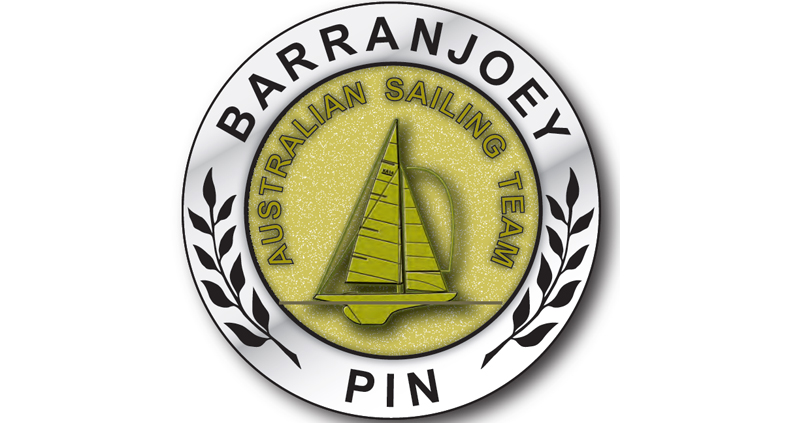
The Pins are uniquely numbered.
Barranjoey crew member James ‘Dick’ Sargeant became emotional as he received Pin No.28, recalling stories of their groundbreaking triumph more than half a centurya go.
Allen then presented Pins to the latest recipients, current Australian Sailing Team 49er crew David Gilmour (No.205) and Joel Turner (No.206), who are preparing for the World Championships in Denmark in August.
“It sets a really big platform that we have to work from,” Turner said.
“There’s a lot of history in our sport. We know that Australians have been very successful. It sets us up with [the knowledge of] how hard we have to work. “We’re definitely under no illusion that it’s an easy target to get an Olympic medal, but that’s what we’re here for.”
Article by David Sygall, Australian Sailing
*Eligibility for Barranjoey Pin
In order to be eligible to receive the Barranjoey Pin, athletes must either have:
- Competed for Australia in an Olympic boat class1 at a World Championship, IYRU Women’s World Championship or Paralympic World Championship and placed Top 10 at that event.
- Competed for Australia at the Olympic or Paralympic Games in sailing.
- Achieved Australian Sailing Team (AST) status in an Olympic boat class following its inception in 2006.
1. the boat class must have been a current Olympic boat class at the time of competing (i.e. Elliott 6m was only in for the 2012 Olympic Games, therefore someone who competed in this event outside the years of 2009-2012 would not be eligible).
Australian Sailing Barrenjoey Pin Awards
Published June 5th, 2018 by Geoff Waller, more Sailing News at www.worldonwater.tv every Friday
The Barranjoey Yacht
BARRANJOEY is a timber racing sloop built in Australia in 1963. The 5.5 metre class racing yacht was built for (Sir) Bill Northam to contest the 1964 Olympic trials, which it won. It then became famous throughout Australia when it won Australia's first gold medal in Olympic sailing competition at the 1964 Tokyo Olympics.
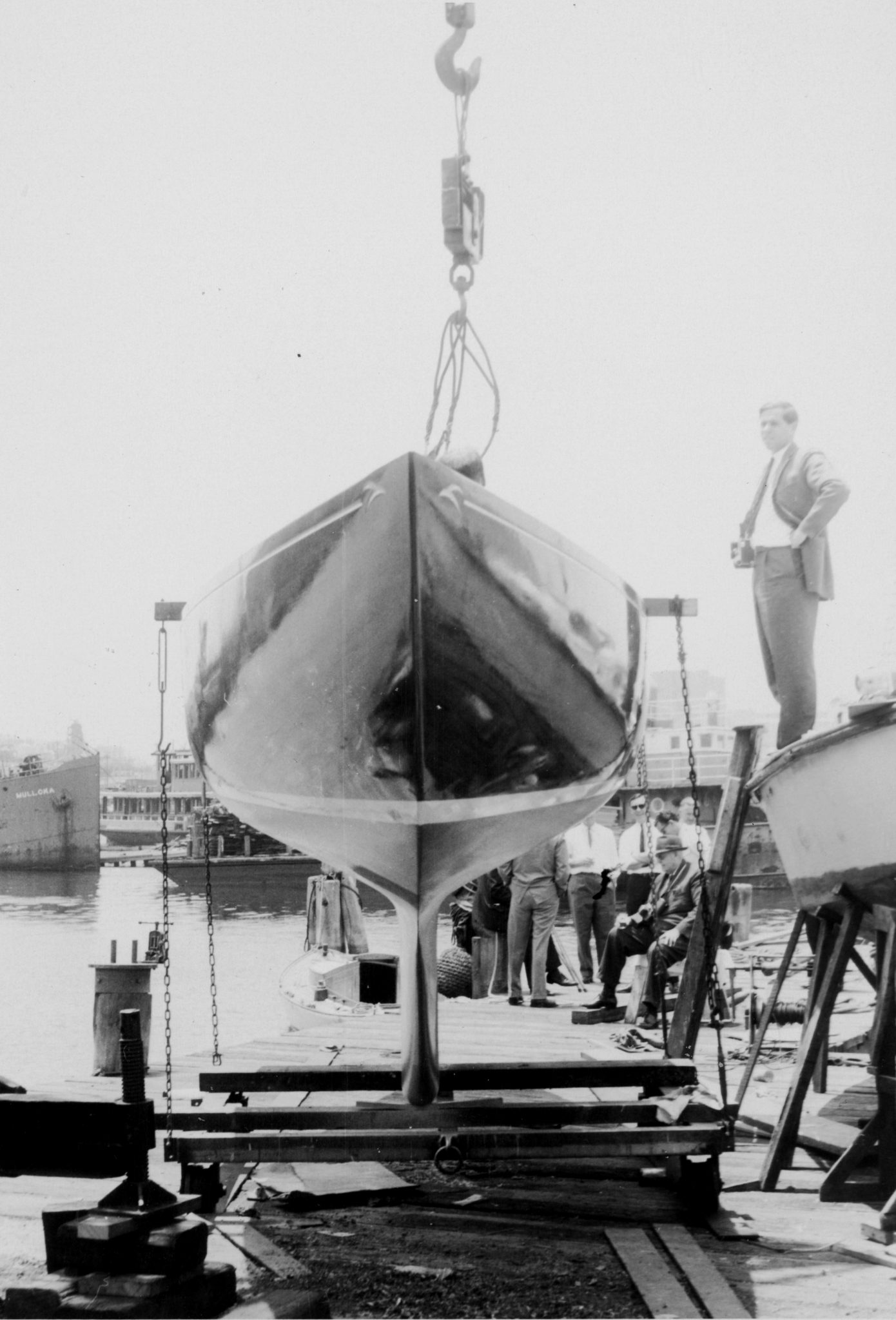
Barranjoey is launched (Christmas Eve, 1963). Photograph; Sir William Bill Northam album Sydney Heritage Fleet. Reproduced courtesy of the Australian National Maritime Museum
BARRANJOEY is 9.75 m long, planked in mahogany, sloop rigged and handled by a three man crew. BARRANJOEY's gold medal win at the 1964 Olympics also created history in other ways. The skipper Bill Northam was 59 years old at the time and a grandfather with five grandchildren, and this made him a popular figure. He also brought a sense of fun to the Olympics in contrast to other more serious competitors.
Northam was teamed up with a young crew, Dick Sargent and Pod O'Donnell and had commissioned BARRANJOEY especially for the Australian trials. The crew beat more fancied rivals who had greater experience in the class and the Olympics.
The Olympic races took place on Tokyo Harbour and the gold medal became a hard fought affair in the last heat. Their main rival from the USA had to win that race to go ahead on points, but he was disqualified for an infringement at the finish when he made a desperate move to try and pass the leader. BARRANJOEY finished 4th and had enough points to secure the gold medal.
The wooden boat was built in Sydney to a design by the American naval architect Bill Luders, one of the premier designers for the 5.5 metre class. The builder was the Jeff Clist, a highly respected shipwright and boat builder whose attention to detail ensured it was built accurately to the plans and critical measurement points that are an essential part of the design. Bill Northam allowed others to charter the boat in later years.
In the 1970s it went on display outside of the Royal Prince Alfred Yacht Club at Pittwater. In the mid 1980s the club and Northam's family donated BARRANJOEY to the Sydney Heritage Fleet at the Australian National Maritime Museum.
Since 2012 the yacht has been on display at Wharf 7 in Darling Harbour, showing off its beautfully varnished hull. This is the yacht you can see in the background of the video during the above presentation. In 2004 it was restored to sailing condition and raced in the 5.5 metre class world championships held in Sydney. BARRANJOEY was sailed by the same crew who had the use of the yacht in the late 1960s. [1.]
Vessel Number: HV000061
Date: 1963
Designer: Bill Luders
Builder: Jeff Clist
Previous Owner: Sir William Northam
Dimensions: Vessel Dimensions: 9.75m x 1.83m x 1.37m (31.99ft. x 6ft. x 4.49ft.)
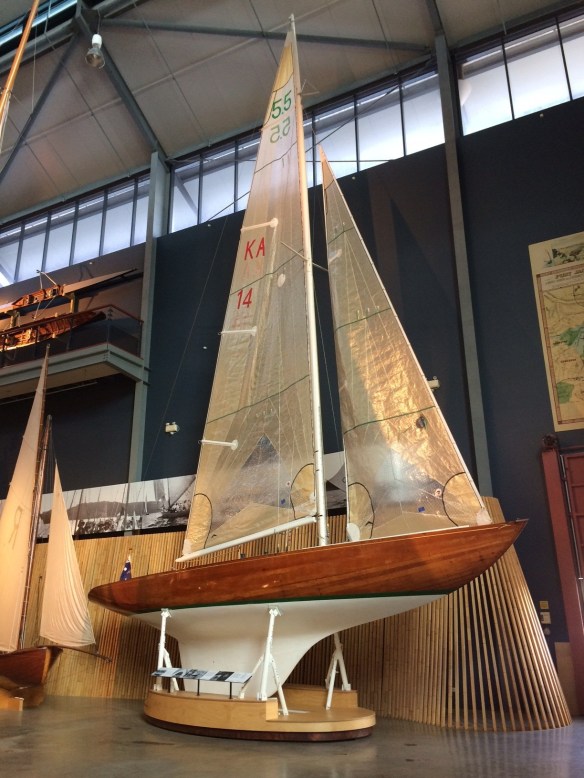
The BARRANJOEY, currently on display at Wharf 7 and part of the Sydney Heritage Fleet Collection. Reproduced courtesy of the Australian National Maritime Museum
Sir William Herbert "Bill" Northam, CBE (28 September 1905 – 2 September 1988) was an Australian Olympic yachtsman and businessman. Born in Torquay, Devon on 28 September 1905, one of seven children of William Northam, 'of independent means', and his wife Kathleen, née Pardoe, his family migrated to Australia when Bill was still very young and settled in Sydney.
MR. W. NORTHAM.
Mr. William Northam, who died at his residence in Roseville on Tuesday, was on the green of the Roseville Bowling Club on Monday morning, when he had a seizure. Mr. Northam was at one time managing director of the Australian Provincial Assurance Association and chairman of directors of Starkeys Ltd. Up till the time of his death he was a director of the Chilcott Engineering Co and of the Victoria Park Racing Club. He was also a prominent Mason.
Mr Northam who was born in Tavistock England 70 vears ago is survived by Mrs Northam, four daughters and three sons.
The funeral took place yesterday afternoon at the Northern Suburbs Crematorium. A service at Wood Coffill's funeral parlours at Chatswood was conducted by the Rev W J Roberts. The Masonic ritual was read at the Crematorium by Mr C H Finch of Lodge Roseville.
The chief mourners were Mrs Northam (widow) Misses Olga and Joan Northam (daughters) Messrs William, Dudley and Kenneth Northam (sons).
Amongst those present were Messrs E S Paul chairman of directors of the Australian Prudential Association and G Bruce Smith (manager), B Davidson, F Bligh and T Watson (Tooth & Co), KL Colloway and MJ Molloy (Tooheys Ltd) CH Finch and J W Cattad (Lodge Roseville
Crlonil) H M Bolera (Wine and Spirit Association) Messrs VV J Phypers (Liquor Trades Defence Lnloni F Marsden and J Sing (Johnson and Johnson) V. Donohoe (Victoria Park Racing Club I J L Rut m en Uohnnv Walker) R W C Dm Is I Caldwell s Ltd I J slltcroJt (ULVA) H Hackett J Elder O Steinbeck O Reichet S Woods J B Duncan W Munro H McMahon W H Bvrne P Gov C Richardson A Zweck ind J R Limnlo i.h (Roseville Bowling Clubl H Klrb\ A Williams R J Colvin V A Brown 1 111 W lard ne K Garney L R Weldon A E Holtnnd W C Milne D G Donald H Smith Ansted p E Harrison W Renshaw J Williams C Davies A Phillips C E\erln"ham T G McKinney J N Campbell W Wingrove, M laird R T Hough N Shaw H Medcalf M Oosper G Webb J Clarke D Allen K Donald D K McLrod J W Turner W Ha.elton J Tyrrell J Ross R Craig D Storey C Watti A Richards K Irrois P Fersu*on A Simpson H Mlll-r W McLean S Hines H V Faller r M trhrl! L Mr M rrnv r simpson and E R Purtorri. MR. W. NORTHAM. (1936, June 12). The Sydney Morning Herald (NSW : 1842 - 1954), p. 8. Retrieved fromhttp://nla.gov.au/nla.news-article17242649
Mr. Northam had a successful career in business before becoming an Olympian. He was simultaneously chairman of the Australian branches of two major companies: American pharmaceutical company Johnson & Johnson, and British sports equipment brand Slazenger.
He also loved racing on roads prior to discovering sailing and racing on water:
MOTOR CYCLING.
BILL NORTHAM
In Great Form
HIGH powered cars participated in the Sydney Bicycle and Motor Club's hill climb at Mr. Hick's property at Prospect yesterday. Bill Northam, In a 16 h.p. 6-cylinder Austin with handicap of 26 seconds, was the outright winner. In the first round he defeated Spurgeon (Ford). In the second round the Austin beat Leo Spies (President Studebaker). In the third round Northam beat Ted Patterson (Chrysler). In the semi-final Ted Poole (Studebaker) went down to Northam. In the final Northam beat Mrs. J. A. S. Jones (Alfa Romeo) by 6 lengths.
MOTOR CYCLING. (1929, September 8). Truth (Sydney, NSW : 1894 - 1954), p. 8. Retrieved from http://nla.gov.au/nla.news-article169323147
W H Northam, 'Bill', took up sailing at age 46 after he moved to Pittwater. He purchased a number of boats over the next few years: his first,Gymea, which ran into the starter's boat in her first race; the eight-metre yacht Saskia, with which he won the prestigious Sayonara Cup for the Royal Sydney Yacht Squadron in 1955 and 1956; and Caprice of Huon, which came 9th in the 1963 Sydney to Hobart Yacht Race. He was also a crew member on Gretel, Sir Frank Packer's challenger in the 1962 America's Cup. Gretel Park in Newport is named for this yacht.
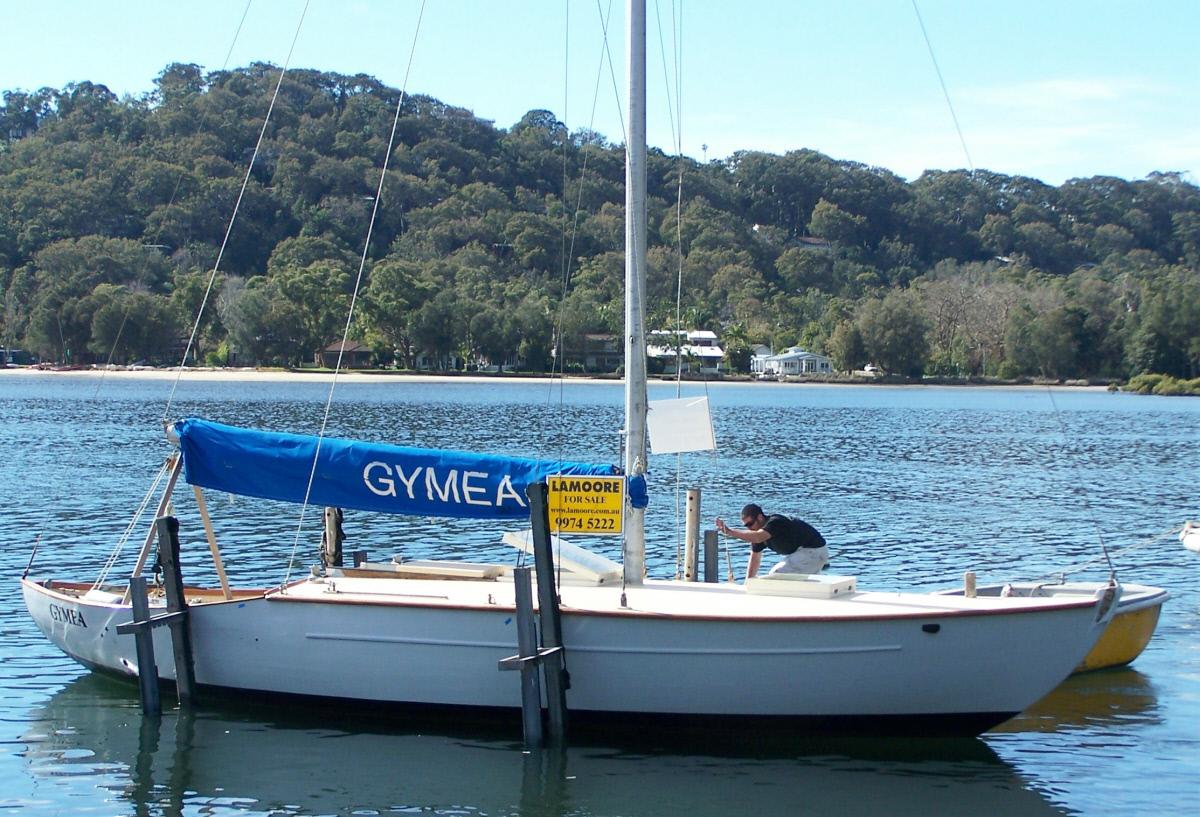
Sydney Yacht Wins Race To Swansea
NEWCASTLE, Friday. The Sydney yacht Gymea, skippered by W. A. Northam, won the Sydney-Swansea ocean race to-day.
Ruthean (V. Toll), which was first to finish, completed the journey in 7hrs 46m. It was unplaced on corrected time.
Twenty-two yachts competed. They left Sydney at 10 o'clock last night. A SSW breeze, which continued until midnight, assisted the fleet.
Placed after Gymea were Bernice (Lake Macquarie), E. N. Raisbeck, 2; Lahara (Syd-ney), D. A. Ashton, 3; Vel-sheda (Lake Macquarie), G. R. Smith, 4; Aquarelle (Sydney), N. H. McEnally, 5.
Sydney Yacht Wins Race To Swansea (1953, April 4). The Sydney Morning Herald (NSW : 1842 - 1954), p. 3. Retrieved fromhttp://nla.gov.au/nla.news-article18371943
Gymea is also now part of the Sydney Heritage Fleet register of the ANMM. Built in 1939 by Charles Larson, Designer A C Barber, she has always been based in Sydney. The deep keel and raised deck were classic proportions for the period.
After World War II GYMEA took part in the early days of offshore racing, competing in the 1947 and 1948 Sydney to Hobart races. In 1951 it is recorded as the handicap winner of the Royal Prince Alfred Yacht Club's 230km Islands Race, finishing third over the line in rough conditions, an excellent performance for a small yacht. The then owner was G L Carter, who had other craft with the same name and was a successful skipper for many years. Carter also sailed GYMEA in the 1947 and 1948 Sydney to Hobart yacht races.
GYMEA's most notable owner was Bill Northam. Another famous Sydney sailor, Gordon Ingate, taught Mr. Northam to sail on GYMEA. She now races with Sydney Amateur Sailing Club as a vintage yacht.
Wonder Yacht Coming
A Sydney business director, Mr. H. W. Northam has bought Great Britain's champion eight-metre racing, yacht, Saskia, in an attempt to capture the highest racing honours in Australia. The 22-year-old Saskia, will reach Sydney by cargo ship, Adelaide Star.
Saskia is probably the best known eight-metre racing yacht in the world, having won 83 major sailing events. Mr. Northam bought her from Mr. Kenneth Preston, skipper of the British sixmetre racing team.
Mr. Northam said yesterday: "Saskia represented Great Britain in the 1936 Olympic Games and won the Seawanaka Cup, held between the U.S.A. and Britain, in 1932 or 1933.
Duralium Mast
"If they will hold eight-metre sailing events at the Melbourne Olympic Games, Saskia will be very handy for Australia.
"She is purely a racing yacht. There are no sea'ts for the crew. She has a duralium mast and is mechanically controlled by winches."
Mr. Northam added that Saskia's first race in Sydney probably would be for the Norn Cup on October 24.
"After that, she will be out to recapture for New South Wales the Sayonara Cup. Wonder Yacht Coming (1953, October 11). The Sun-Herald (Sydney, NSW : 1953 - 1954), p. 85. Retrieved from http://nla.gov.au/nla.news-article28661382
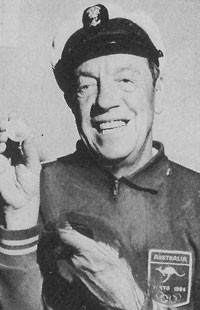 In 1963, Northam set himself the challenge of competing in the Olympic Games. He travelled to the United States, where he arranged for naval architect Bill Luders Jr. to design and build him a yacht, which was namedBarranjoey.
In 1963, Northam set himself the challenge of competing in the Olympic Games. He travelled to the United States, where he arranged for naval architect Bill Luders Jr. to design and build him a yacht, which was namedBarranjoey. With fellow Gretel yachtsmen Peter 'Pod' O'Donnell and James Sargeant, both more than 30 years younger than him, Northam took Barranjoey to a successful run of the 1964 Australian titles, the Olympic trials and further challenge races, until the team qualified for the 1964 Summer Olympics in Tokyo, Japan, despite misgivings about Northam's age, now 59. Northam marched in the opening ceremony with his son Rod, who was a reserve member of the rowing team.
The Australian team competed in the 5.5 metre class, starting well with wins in the first, fourth and sixth races, although they were disqualified in the fifth. Northam's main rival, the yacht Bingo skippered by American author John J. McNamara won the second and third races, and McNamara would have taken the gold medal if Bingo won the final race and Barranjoey finished fifth or worse.
In a fierce race for first place against Swedish boat Rush VII, McNamara was disqualified, and Northam and his crew finished fourth, qualifying them for the gold medal. It was Australia's first Olympic gold for sailing, and Northam remains the oldest Australian to win an Olympic gold medal.
The Oldest Olympian
By CYNTHIA ROBINSON
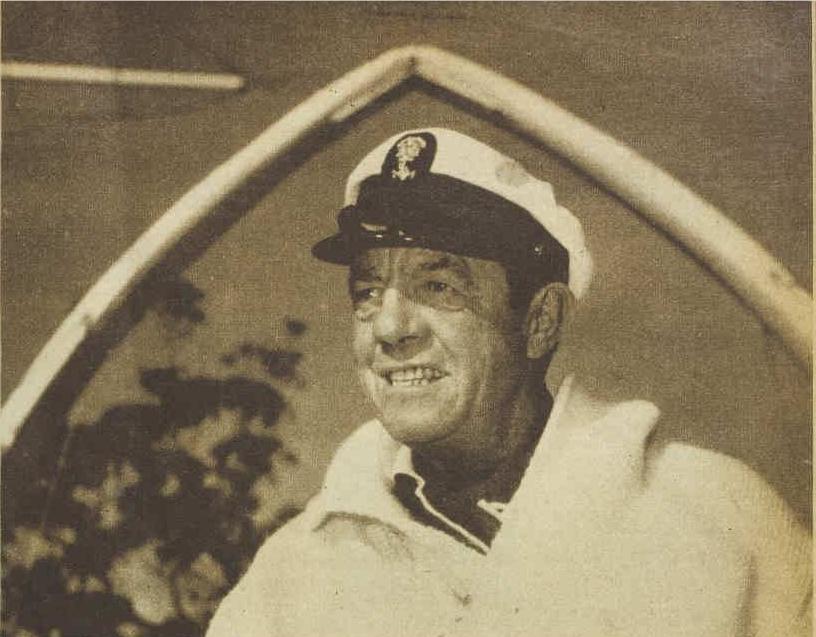
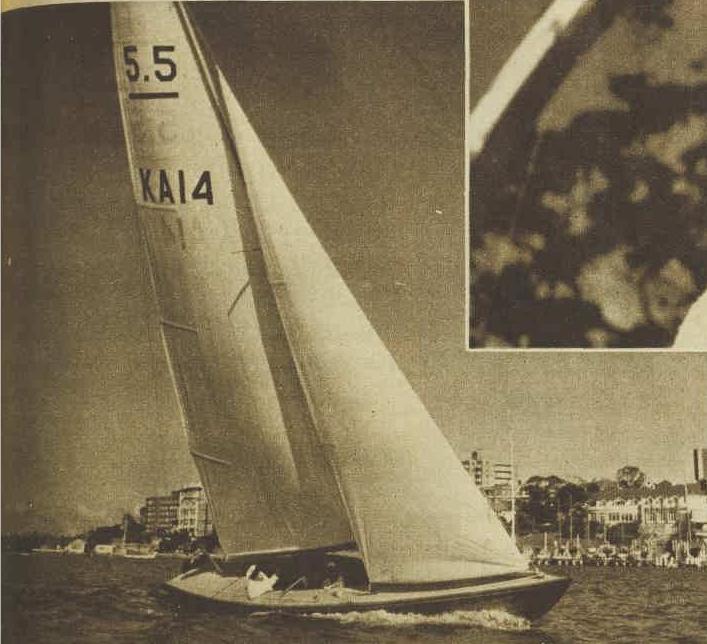
YACHTSMAN Bill Northam, of Pittwater, N.S.W., and (left) his yacht, Barrenjoey, in Sydney. With Peter O'Donnell and Dick Sargent they will represent Australia in Tokyo. He's going after the yachting honors with a boy's gusto . . . and the smile of a man who has won a jackpot
Life begins at 59, according to genial Bill Northam, who recently became the oldest sports-man ever chosen to represent Australia at the Olympic Games.
BILL NORTHAM is the oldest Olympian in calendar years. But in terms of energy and boyish enthusiasm he's as young as any teenager in the Australian contingent for Tokyo.
Mr. Northam, a grand-father and business executive, has his Olympic blazer (and accompanying wide-angled grin) for yachting.
He'll represent Australia in his elegant 5.5-metre yacht Barrenjoey with crew members Peter ("Pod") O'Donnell- and Dick Sargent, who were deckhands in Gretel's America's Cup bid.
"Yes, we'll be there in Tokyo, and we'll be ready to win, too," said Mr
Northam with a glint in his eyes.
This Olympic selection is the most amazing, exciting thing that's happened in my life, and I'm going to make the most of it …
Born in England, he came to Australia when he was seven and was educated at Sydney's first Knox College. He decided to go to sea when he left school.
' My father decided otherwise, though, and talked me out of it," he said. "So I did the next best thing and became a marine engineer's representative, earning the princely sum of 8/6 a week.
"But there wasn't enough action in this life for me. I wanted to be a salesman, and I badly wanted to drive racing-cars. So I settled for the speed first, and for eight years raced cars round Australia.
"Then, a short 31 years ago, I joined this company as a salesman and did just about every job in the place before I became chairman.
….
In 1955 and 1956 he won the Australian 8-metre championship, bringing victory in this event to N.S.W. for the first time in decades. He then turned his attention to ocean racing. In 1957 he was going well in the Sydney-Hobart race until Caprice of Huon lost a mast off Port Kembla. Determined to do better, he was back again the next year, and this time was third across the line.
In 1962, when he was in the United States for the America's Cup races (in which his elder son, Brian, was a crew member of Gretel), he studied new trends in yachts, and last year Jazzer, a stylish 42footer, was built for him from an imported design.
"Jazzer-we called her that because she couldn't keep straight-is a beautiful yacht, and I had a lot of success with her," he said. "But last year I began sailing near my home at Pittwater, and I got talked into racing in the 5.5-metre competition there.
"I wasn't too sold on the idea, as I'd never sailed any-thing smaller than a 42 footer before.
"I couldn't help thinking that if I kept on, changing at this rate I'd be sailing in a dinghy or paddling a canoe in another year.
"Anyway, I got enthusiastic enough about the 5.5metre idea to give Jazzer to Brian and to build Barrenjoey.
"It hadn't really entered my head that I'd get serious about racing her, and it didn't look as though we'd do much good last season.
"She wasn't launched till Christmas Eve, and by the time I went to hospital to have a knee cartilage removed it was into the New Year before we got going in Barrenjoey.
"Till then I'd only sailed a 5.5 once, but with those two great boys Pod and Dick in the crew we soon got her moving and we thought we might as well enter the Australian championships.
“A breeze"
"This meant we had only five or six weeks to get ready. But we won three Australian championships and our Australian blazers all within three months.
"Now it's next stop Tokyo.
"With the light sailing conditions we expect there, I think we'll do well. Our toughest opposition will come from America and Russia, and just how we'll get on with that lot I
wouldn't know."
Before leaving for Tokyo, Mr. Northam will be busy sailing, sailing, sailing in a bid to beat the world.
He'll still find time to look after his business interests ("though nobody really expects to see me much till the Games are over") and his many other interests.
It would be a tough programme for most people, but for "young" Bill Northam it's a breeze. Recently he has been as busy as a beaver raising money for the Olympic Fund and he has brought in thousands.
"I suppose I had an unfair advantage," he said with a throaty chuckle. "I just told all my pals in the business world that they could afford to give a few hundred, and they hardly liked to refuse.
"A couple did say: 'You're in the team, what are you worrying about?'
"I'd tell them, 'Yes, I've got my fare, but how am I going to get my boat there? And what's the use of my going if some of my young friends have to stay at home because blokes like you were so mean there was no money for them to get there?'
"It always worked."
Now the money has rolled in, Bill Northam is elated.
"When I saw the athletes march round the Melbourne Cricket Ground at the 1956
Olympics, I thought that it must be the thrill of a life-time," he said.
"Now, by some unbelievable chance, I'll have the chance to find out at first hand."
The Oldest Olympian (1964, June 24). The Australian Women's Weekly (1933 - 1982), p. 17. Retrieved from http://nla.gov.au/nla.news-article51399113
W H Northam had married Esther Barbara Herford on 21 June 1929 at St Andrew’s Church of England, Roseville; she died in a car accident in 1946. He married Alison Mary Dwyer, née Walker, on 10 April 1948 at the district registrar’s office, Chatswood. Serving as an alderman on Sydney City Council from 1956 to 1965, he ran unsuccessfully as the business-oriented Civic Reform Association candidate for lord mayor in 1962.
Appointed CBE in 1966, Northam was knighted in December 1976. His wife Alison had died earlier that year. On 28 May 1977 at his mansion, Hopton Lodge, Bayview, he married with Presbyterian forms a widow Dulcie May Stephen, née Hill.
Hopton Lodge was/is on the waterfront at Bayview. In October 2006 it was listed for $10 Million plus. Set on 3145 square metres, the house was associated with its lengthy ownership by the wealthy pastoralist Sir Roy McCaughey. Its waterfront facilities then (2007) included a bunkhouse, mooring, jetty, boatshed and beach. The property at 1758 Pittwater Road had traded for $5.5 million in 2000, when it was bought by commercial property developer Max Delmege and his wife, Narelle. [2.]
Sir William Northam's new 'voyage'from oceans of space to a harbour haven
...But Sir William Northam and his charming wife Dulcie found Hopton Lodge, their magnificent, million-dollar mansion at Bayview, north of Sydney, "just too much to handle," and they are selling it this month.
To replace Hopton Lodge, set on 3155 square metres, they have chosen a three bedroomed unit at Point Piper, Sydney, with, of course, a harbour view.
Sir William, Australia's first Olympic yachting gold medallist, is taking it all in his stride. "I have no regrets at all." he said about selling and leaving Hopton Lodge after 20 years.
Sir William, optimistic and cheerful, says he is used to changes late in his life - "after all, I was a grandfather and the oldest man at 60 ever to win an Olympic gold medal," he laughed.
Hopton Lodge, built by the late merino stud owner Sir Roy McCaughey and Lady McCaughey, is a big white, ram-bling house with shutters framing the windows. It has a magnificent view north along Pittwater and beyond, taking in the yachtsman's landmark, Lion Island.
Upstairs the house is designed for family living with two master bedrooms and ensuite bathrooms. Downstairs the rooms are large with a guest wing. The main reception vestibule has big, bold, black and white vinyl squares with a huge shaggy oval rug in autumn tonings. The vestibule leads to a sitting-room opening to a sandstone terrace. Folding louvred doors divide the sit-ting-room from the dining-room, which has a matching buffet sideboard unusually decorated with the 12 Zodiac signs. Off the dining-room is the large kitchen leading to the flower preparation room, utility wine storage-room and three-ear lock-up garage....
ROBIN AMADIO
Pictures: KEVIN BROWN
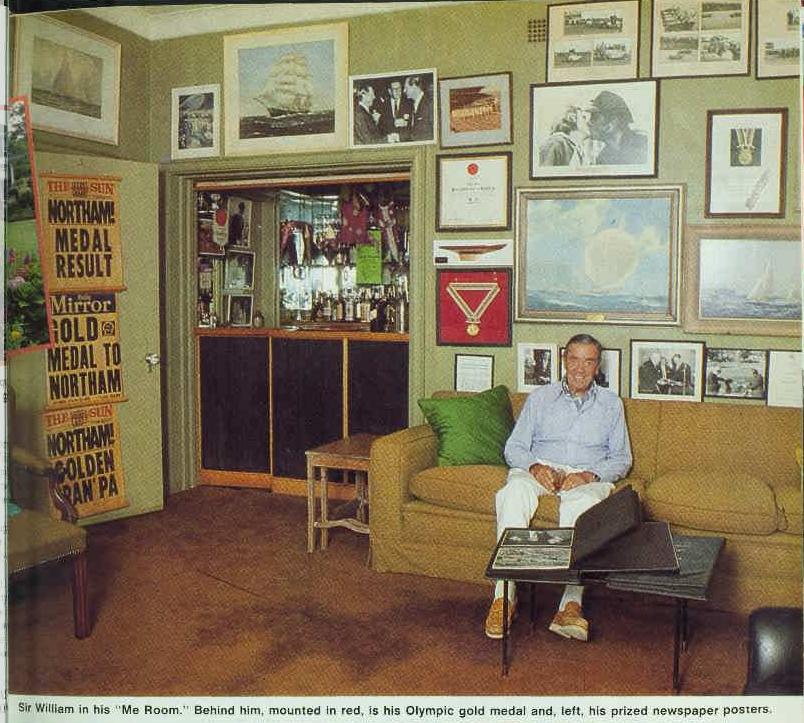
Sir William Northam's new 'voyage' from oceans of space to a harbour haven (1981, March 11). The Australian Women's Weekly (1933 - 1982), p. 74. Retrieved from http://nla.gov.au/nla.news-article55458369
Sir Bill Northam was a renowned charity worker and Olympic fund-raiser. In 1965 he was named Australian 'Father of the Year'. Sir William was a gregarious individual who smoked heavily and enjoyed whisky. Survived by his wife and the daughter and two sons of his first marriage, he died on 2 September 1988 at Woollahra. A memorial service was held at St Mark’s Anglican Church, Darling Point. [3.]
Honours
1965: Father of the Year
1 January 1966: Commander of the Order of the British Empire
31 December 1976: Knight Bachelor for services to the community
1978: AOC Olympic Merit
1985 - inaugural inductee Sport Australia Hall of Fame
2017 - inaugural inductee Australian Sailing Hall of Fame
William Northam CBE - Sailing
By Sport Australia Hall Of Fame
Bill Northam was always sports minded and after dabbling in athletics as a youngster, became a dedicated motor sportsman in his early twenties. Northam was among a group of brave pioneers who raced cars on the old dirt and gravel circuit at Phillip Island (Victoria) and for a time also raced motorcycles.
Australia's final gold medal at the 1964 Tokyo Games, the first the nation had ever won in sailing, went to its 5.5 metre class crew, Bill Northam, Peter 'Pod' O'Donnell and James Sargeant. Northam, the skipper, was 59 and the grandfather of five, the oldest Australian ever to have won an Olympic medal. The Japanese fondly dubbed him Ogesan (old man). He may also have been the most garrulous. He heckled his opponents on jetties and across the water, argued good naturedly during races with O'Donnell and Sargeant, and unsettled the man he considered his main rival, the American skipper John McNamara.
Northam was one of the sport's more refreshing characters, quite dedicated to winning but never prepared to take himself too seriously. He had had a successful career in business, as chairman of both Johnson & Johnson and Slazenger. He did not take up sailing until he was 46.
Northam's introduction to sailing came after he bought a waterfront property at The Basin, Pittwater, Sydney, looking across at the Barrenjoey lighthouse (which inspired the name of the boat he took to the 1964 Games). Taken for an outing by a neighbour, he fared badly at handling the sails, but found he had a real aptitude at the helm. He sensed the capacity to feel the boat beneath him, almost anticipate its movement, and he attributed that to his experience of racing cars on dirt tracks. So enthused was he that he bought a boat, 'Gymea', and began to race her; undeterred by a disqualification in his first race for running into the starters boat, he had enough success to inspire him to tackle some larger challenges. After buying an 8 metre yacht 'Saskia' in England he showed his competitive nature and sailing skills by winning back for the Royal Sydney Yacht Squadron the prestigious Sayonara Cup in 1955 and 1956. He then had many successes in 'Caprice of Huon' (Sydney to Hobart) and the Sabre class 'Jazzer'. He was a member of Frank Packer's 'Gretel' syndicate for the 1962 America's Cup.
In 1963 he decided to set himself a new challenge, the Olympics. He went to the United States, sought out naval architect Bill Luders, and had him build the 5.5 metre craft he called 'Barrenjoey'. He asked O'Donnell and Sargeant, both more then 30 years younger than him to join him, and he entered the 1964 Australian titles and Olympic trials, against skippers like Jock Sturrock and Norman Booth.
Northam was an audacious sailor, happy to use unconventional tactics. Although 'Barrenjoey' and her crew won the championship and Olympic selection, then another set of challenge races, Northam had his detractors; some said he was too old, and many pointed out that Jock Sturrock had previously been to four Olympic Games.
Northam marched in the Tokyo opening ceremony with his son Rod, an emergency in the rowing team. No father and son had previously represented Australia at the same Olympics; this time two pairs did - the Northams and the Roycrofts, Bill and Barry.
With Northam as helmsman, Sargeant the for'ard hand and O'Donnell on the main sheet, 'Barrenjoey' made its mark quickly, with a win in the first raced. He distracted his rivals as they approached the line, claiming that they were too early, as they checked their watches and turned about, he gave himself clearance. McNamara, the danger man from the United States, finished 10th in the first race, and Northam couldn't resist the temptation to heckle.
McNamara, in 'Bingo', went on to win the next two races. The Australian craft won the fourth and sixth, but was disqualified in the fifth. With the final race to go, Australia had 5407 points, the United States 5106. McNamara could take the gold only if he won, and 'Barrenjoey' finished worse then fourth.
In a desperate finish, fighting out first place with the Swedish boat 'Rush VII', McNamara was disqualified. The Australians finished fourth, qualifying as overall winners.
After the Tokyo Olympics, Australians honoured him with the award of Australian Yachtsman of the Year and a commemorative sculpture in Sydney Park.
He was made a Commander of the Order of the British Empire in 1966 and in 1976 he was knighted for his distinguished services to the community.
Bill Northam, Peter O’Donnell And James Sargeant To Be Inducted Into The Australian Sailing Hall Of Fame
November 2, 2017 by Australian Sailing
Australia’s first Olympic sailing gold medallists, Sir William (Bill) Northam CBE (1905-1988), Peter (Pod) O’Donnell (1939-2008) and James (Dick) Sargeant (born 1936) will be inducted into the Australian Sailing Hall of Fame this week, recognized for their gold medal winning performance at the Tokyo 1964 Olympic Games.
“The achievement of Bill Northam CBE, Pod O’Donnell and Dick Sargeant in winning Australia’s first Olympic sailing gold medal in the 5.5mR class at the Tokyo Olympic Games. opened up a world of opportunity for generations of Australian Olympic sailors to come,” said the Australian Sailing Hall of Fame Selection panel.
When the trio won their Olympic gold medal, Northam, the skipper, was 59 and the grandfather of five, the oldest Australian ever to have won an Olympic Gold medal.
Northam only started sailing at the age of 46. After winning the Sayonara Cup in 1955 and 1956, Northam then had many successes with Caprice of Huon in the Sydney to Hobart Yacht Race and raced the Sabre class Jazzer.
In 1963 Northam decided to set himself a new challenge, the Olympics. He went to the United States, sought out naval architect Bill Luders, and had him design the 5.5 metre craft he called Barranjoey* – in a misspelt homage to the northern beaches headland in his native Sydney. He asked accomplished sailors, O'Donnell and Sargeant, both more than 30 years younger than him to join him, and entered the 1964 Australian titles and Olympic trials, against skippers like Jock Sturrock and Norman Booth.
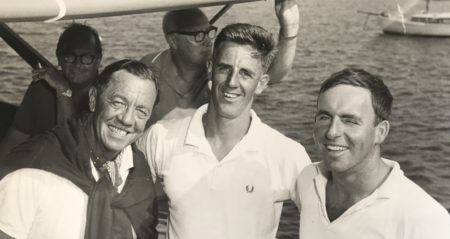
Bill Northam, Dick Sargeant and Peter O’Donnell at the Olympic trials on Lake Macquarie. Image courtesy of Dick Sargeant (Jack Galesailed with the late Tony Carr in the 5.5 "Altair", finishing runner up to Sir William Northam in the 1964 Olympic Trials.)
Although Barranjoey and its crew won the championship and Olympic selection, then another set of challenge races, Northam continued to have his detractors. Some said he was too old, and many pointed out that Jock Sturrock had solid Olympic experience, having previously been to four Olympic Games. However, Northam, O’Donnell and Sargeant had won the Olympic trials and therefore earned the right to compete for Australia in the 1964 Tokyo Olympic Games.
Northam marched in the Tokyo opening ceremony with his son Rodney, a member of the rowing team. No father and son had previously represented Australia at the same Olympics; this time two pairs did - the Northams and the Roycrofts, Bill and Barry (Equestrian).
With Northam as helmsman, Sargeant the for'ard hand and O'Donnell on the main sheet, Barranjoey made its mark quickly at the Olympic regatta, with a win in the first race. McNamara, the danger man from the United States, finished 10th in the first race, and Northam couldn't resist the temptation to heckle.
McNamara went on to win the next two races in 'Bingo'. The Australian team won the fourth and sixth races. With the final race to go, Australia had 5407 points, the United States 5106. McNamara could take the gold only if he won, and Barranjoey finished worse than fourth.
In a desperate finish, fighting out first place with the Swedish boat Rush VII, McNamara, the American favourite, was disqualified. The Australians finished fourth, qualifying as overall winners, and taking Australia’s first sailing gold medal.
After the Tokyo Olympics, Northam was honoured as Australian Yachtsman of the Year. In 1966 he was made Commander of the Order of the British Empire in 1966 and in 1976 was knighted for his distinguished services to the community.
Northam, O’Donnell and Sargeant were also all involved with the Jock Sturrock-skippered Gretel when it challenged for the America’s Cup in 1962.
Although he did not attend another Olympic Games after Tokyo, O’Donnell continued his involvement with the Australian and international sailing world in the ensuing decades. He won the 1974 world championship in the 5.5-metre class, with Norman Booth and Carl Ryves.
In 1980, O’Donnell won the International Etchells 22 world championship, with Richard Coxon and Dick Lawson, and was Australian Yachtsman of the Year in 1979-80. O’Donnell and Coxon were selected to go to the 1980 Moscow Olympics in the Star class, but the sailing contingent withdrew from the Australian team due to the proposed boycott.
After Tokyo, Dick Sargeant also continued to sail at the highest level for many decades. In 1968 he competed at the Mexico City Olympics, where he and Carl Ryves sailed their Flying Dutchman class boat into fourth place, an agonising 0.7 points off a medal.
_______________________
*Barranjoey is an earlier spelling of 'Barrenjoey' and preferred by many historians.
1. BARRANJOEY bio per ANMM Heritage Fleet webpage
2. Top end prices go through roof. Jonathan Chancellor Property Editor. Sydney Morning Herald. March 30, 2007.
3. R. I. Cashman, 'Northam, Sir William Herbert (1905–1988)', Australian Dictionary of Biography, National Centre of Biography, Australian National University, http://adb.anu.edu.au/biography/northam-sir-william-herbert-14999/text26188, published first in hardcopy 2012